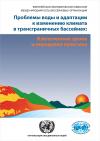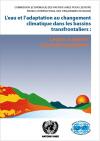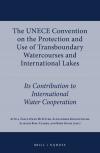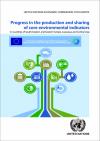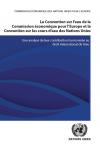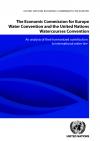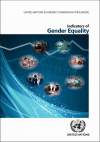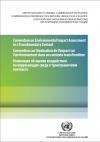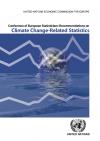Publications
Displaying Results 981 - 1000 of 2807
- Pусский
- Français
La publication vise à compiler, analyser et diffuser les expériences, et par la même à démonter et illustrer les étapes importantes, les enseignements tirés, ainsi que les bonnes pratiques à prendre en compte lors de l’élaboration d’une stratégie d’adaptation au changement climatique pour la gestion de l’eau dans un bassin ou un contexte transfrontière. Elle comprend des enseignements tirés et
- English
- English
The Framework Code takes account of the latest scientific knowledge and experience in ammonia abatement, as described in the recent update of the guidance document on preventing and abating ammonia emissions from agricultural sources (ECE/EB.AIR/120). Its purpose is to provide the Convention’s Parties with easily understandable information on the good practices that are necessary to reduce
- English
The book The UNECE Convention on the Protection and Use of Transboundary Watercourses and International Lakes: Its Contribution to International Water Cooperation edited by Tanzi, A., McIntyre, O., Kolliopoulos, A., Rieu-Clarke, A., and Kinna, R. and published by Brill/Nijhoff in
- English
Preventing Drink Driving in Africa is an e-book published by the United Nations Economic Commission for Europe (UNECE), the United Nations Economic Commission for Africa (UNECA), and the International Alliance for Responsible Drinking (IARD) and is
- English
This study is the contribution of the ECE Region to the Eleventh Session of the United Nations Forum on Forests. Using the best available data, it examines progress of the forest sector in the ECE Region towards the achievement of the four Global Objectives on Forests, adopted by the United Nations General Assembly in 2007. On the basis of this assessment as well as the forest sector outlooks
- Pусский
Настоящее исследование было подготовлено Комитетом ЕЭК по лесам и лесной отрасли (КЛЛО) и Европейской комиссией ФАО по лесному хозяйству (ЕКЛХ) для одиннадцатой сессии Форума ООН по лесам. На основе наилучших имеющихся данных в нем проводится анализ прогресса, достигнутого лесным сектором региона ЕЭК в деле выполнения четырех глобальных целей в отношении лесов, которые были утверждены
- English
UNECE Countries in Figures presents a profile of social and economic indicators for each of the 56 UNECE member countries.These profiles, prepared by the UNECE Statistical Division, are intended to be of interest to readers not necessarily familiar with statistical terminology or with interpreting statistical tables. A glossary of terms and list of references is available at the back of the
- English
Resilience to disasters for sustainable development (ECE/INF/NONE/2015/2/Rev.1) – revised in October 2019All the countries of the United Nations Economic Commission for Europe (UNECE) region, including the most developed, are vulnerable to disasters. As one example, in 2019, the June and July
- Pусский
ECE/CEP/175
- English
Available in English and Russian (not laid out). (ECE/CEP/175, 44 pp.)
The United Nations Economic Commission for Europe (UNECE) Programme on Environmental Monitoring and Assessment assists UNECE member States in working with environmental data and information to enable their timely flows and adequate assessment. In this way, the Programme helps enable an informed decision-making process,
- Français
Approximately 40 per cent of the world’s population live in river basins that cross national borders. Transboundary river basins cover nearly one half of the earth’s land surface and account for about 60 per cent of global freshwater flow. These basins link populations and create hydrological, social and economic interdependencies between countries. Transboundary water cooperation is therefore
- English
Approximately 40 per cent of the world’s population live in river basins that cross national borders. Transboundary river basins cover nearly one half of the earth’s land surface and account for about 60 per cent of global freshwater flow. These basins link populations and create hydrological, social and economic interdependencies between countries. Transboundary water cooperation is therefore
- English
Lessons on Monitoring and Implementation of the MDGs for the Post-2015 Development AgendaThe adoption of the United Nations Millennium Declaration and its formalization into the Millennium Development Goals (MDGs) represented a major achievement in terms of providing a framework for advancing development in an inclusive manner. Implementation of the framework, however, has proven to be quite
- English
This brochure provides statistics on the main indicators for road, rail and inland waterways for countries in the UNECE region.The brochure is available for download in English.
- English
Statistics and indicators that reflect the realities of the lives of women and men are needed to describe women’s and men’s role in the society, economy and family, to formulate and monitor policies and plans, monitor changes, and inform the public. In 2010, the Conference of European Statisticians (CES) established the Task Force on Indicators of Gender Equality, to improve the monitoring of
- English
- English
Statistics and indicators that reflect the realities of the lives of women and men are needed to describe women’s and men’s role in the society, economy and family, to formulate and monitor policies and plans, monitor changes, and inform the public. In 2010, the Conference of European Statisticians (CES) established the Task Force on Indicators of Gender Equality, to improve the monitoring of
- English
These first ever Recommendations on Climate Change-Related Statistics are aimed at improving existing official statistics to support climate change analysis and reporting on greenhouse gas emissions under the Kyoto Protocol. The focus is not on scientific or meteorological data describing changes in weather and climate, but rather on statistics that are relevant for analysing climate change,


